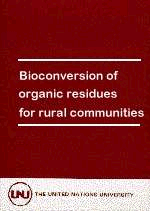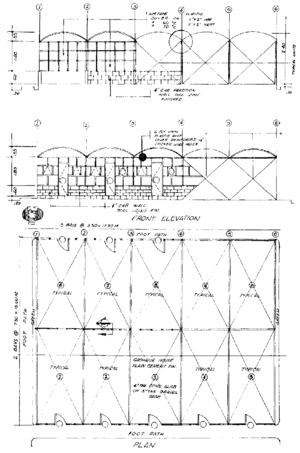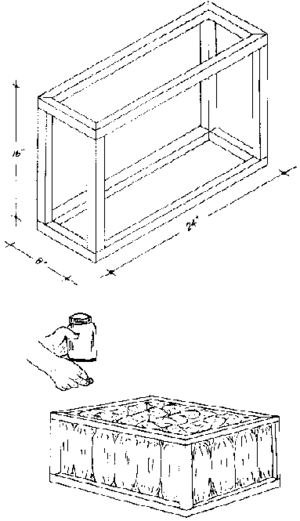
Bioconversion of Organic Residues for Rural Communities (UNU, 1979, 178 p.)
Mushroom production technology for rural development[edit | edit source]
R. V. Alicbusan
National Institute of Science and Technology, National Science Development Board, Manila, Philippines
One of the low-cost, appropriate technologies being offered by the National Institute of Science and Technology, National Science Development Board (NIST-NSDB) for rural development is the production of the tropical mushroom Volvariella volvacea (Bull ex Fr.) Singer. This variety of mushroom usually grows on piles of decaying rice straw, sawdust, coffee pulp, sugar-cane bagasse, oil palm extraction wastes, etc. The mycelium grows outward towards the sunlight, which stimulates the growth of small nodules called pin-heads. These small white bodies are approximately the size of the pins Filipino women wear in their hair, hence the name. Great numbers of them develop almost simultaneously all along the sides of the growth substrate. Within two to three days the clour changes from white to black, then to brown, and gradually fades as the mushrooms grow larger. There are, however, some strains that are dark brown or black. They may be chestnut- or egg-shaped.
The young mushroom is covered initially with a thin membrane called the volva As the mushroom develops, the stem or stipe elongates, gradually pushing the cap upwards, which causes the volva to rupture and remain at the base of the stem. The still unopened mushroom cap is further pushed up to a height of about 6 to 10 cm. Once the stem reaches its maximum height, the cap starts to expand. Initially, the gills are white, but they turn brown once mature basidiospores are produced in the gills. The opened mushroom has a stronger odour and taste attributable to the mature basidiospores.
Figure 1 illustrates the stages of growth of this variety of mushroom. Growth to maturity usually takes five to seven days, depending on the prevailing environmental conditions. Low temperatures (25 - 27°C) slow down development and high temperatures (28 - 35 C) hasten the rate of growth.
The recent expansion of the commercial production of this tropical mushroom in the Philippines is the result of several complementary factors: (1) there is technology available and the climate is favourable to good mushroom production throughout the year; (2) there is plenty of manpower available, ample space, and abundant bedding material; (3) there is high demand for the product both locally and abroad; and (4) financial assistance can be extended by government and private lending institutions.
Given these available resources, field demonstrations were conducted to show farmers simple methods of mushroom culture in different regions of the country. This was done through the 17 regional offices of the NSDB. To hasten the dissemination of the technology, all the Science Field Officers of NSDB were given one month of intensive training in mushroom production. Each regional office was provided with facilities for making mushroom spawn as well as space for mushroom demonstrations, including the construction of a single unit mushroom house.
Seminars were conducted in different barrios to make the people aware of available technology for home mushroom production. There are also technicians in the Tropical Mushroom Research Laboratory at NIST who can extend technical assistance in spawn and mushroom production in different regions.
Materials and methods for growing mushrooms under natural or field conditions[edit | edit source]
The Mushroom Bed Foundation The foundation for bedding material can be soil, concrete, or a wooden bench. A soil foundation is made by raising the soil in the same manner used to build a garden plot to a height of about 12 cm above ground level. It is surrounded by a canal 30 cm wide and 15 cm deep. The earth excavated from the canal is used to elevate the foundation The width of the foundation should be 45 cm, and the length 1 m or more. Sandy soil will not make a strong enough foundation, but this can be remedied by cementing the sides or by constructing a wooden bench 30 cm high with the rest of the dimensions the same.
Rice Straw as Bedding Material
Thoroughly dried, long rice straw is preferable. Properly prepared straw produces a better yield of mushrooms compared to the yield when care is not taken to provide a strong base.
The straws are bundled to a size of about 8 cm in diameter, tied at the middle with abaca twine or any good substitute, cut to a uniform length of 45 cm and soaked in water for three hours. The soaked straw bundles are laid crosswise side by side on top of the bed foundation until the whole length of it is covered. All the butt ends are placed on one side in a layer, alternating between layers. If the butt ends of the first layer are on the left side, the butt ends of the second layer must be on the right side. This manner of arrangement is continued until four to six layers are made. About 240 bundles are needed for a six-layer, 4-metre-long bed. Each layer must be pressed firmly to make the surface level, and should be watered.
Simultaneously with the bed preparation, several crumpled newspapers are soaked in a container with 3 9 of urea per gallon of water. This "fertilized" paper is planted along with the mushroom spawn or seed. The mushroom spawn and soaked paper are first distributed on top of the layer in thumb-sized pieces. The plantings are 5 - 8 cm from the edge of the straw and 5 cm apart. For every six-layer bed 4 m long, three bottles (16 fl. oz.) of spawn are used. One-half bottle of spawn is apportioned to plant one layer. The spawn is buried with the paper 4 cm deep in the layer. The same procedure is repeated on the remaining layers. Any left-over straw is mounded on top to a thickness of about 10 cm at the centre.
The straw bed is protected by an elevated, transparent plastic sheet immediately after the planting. The cover is attached to a bamboo frame to prevent the moisture that accumulates on the plastic from spilling onto the straw.
During the dry season, a four-layer bed is recommended because of lower relatively humidity. Beds of six or more layers are possible in the wet season.
Banana Leaves as Bedding Material
Dried banana leaves, still hanging on the plant, are gathered and cut to a uniform length of 45 cm, bundled to a diameter of 8 cm, and soaked in water for three or four hours
The leaf bed is made in a manner much the same as that used for straw; i.e., the bundles are laid side by side crosswise on the bed foundation, watered, pressed, and planted. Four or sixlayer beds are constructed, depending on the season. The leaf bed also requires the elevated plastic sheet on a bamboo frame immediately after planting.
Care of the Bed
For both rice-straw and banana-leaf beds, no water should be given for the first five days after the bed preparation. During the dry season, the bed may be watered gently but generously on the sixth or seventh day after planting, and this should be repeated once a day until the mushroom pin-heads have developed. During the rainy season, the bed may not need further watering, or at least not as much as during the dry months. Water is applied more along the sides of the bed in the rainy season.
When the mushrooms are at the pin-head stage, the bed should not be watered. Water should be applied only when the mushrooms reach the size of corn seeds and the bed has become somewhat dry.
Harvesting
Under normal conditions, the first harvest of mushrooms is taken 10 to 14 days after planting. The harvest usually lasts for three consecutive days. This is the so-called first flush. The average daily production is 1.2 kg. The bed rests for five to seven days, and another crop is harvested over another two- to three-day period. The average production for the second harvest is 0.42 kg. This manner of production may continue for a month or even longer.
During harvest, the mushrooms must be carefully pulled out whole from the bed. Any portion left behind will decay and permit bacterial soft-rot to spread in the succeeding crops, causing a drastic reduction in yield.
Yield
For a standard 4-metre, six-layer bed, a harvest of 7 kg of buttons or 12.6 kg of fully mature mushrooms can be obtained. This quantity represents the total from the entire productive life of the bed.
Advantages and Disadvantages of These Methods
Both rice-straw and banana-leaf beds are highly adaptable and inexpensive for growing mushrooms as a family project in the rural areas, where labour and materials can be obtained free. Sudden changes in weather conditions do not materially affect production.
Both types of bed require a large quantity of bedding material Yields depend on the volume of bedding material used. Either kind of bed may be hard to manage. Because of side exposure, they easily become infested with pests and diseases.
Growing mushrooms under semicontrolled conditions[edit | edit source]
One possible approach towards establishing a mushroom industry in the countryside is the so-called community level scheme of production. This involves most of the people from all strata in the rural areas, thereby providing an additional source of income to a greater number of persons.
Recently, it has been shown that it is feasible in the Philippines to grow Volvariella mushrooms on a commercial scale in boxes placed in special growing houses. Compared with the ordinary open-bed method, the percentage of yield conversion of box-grown mushrooms was improved from 10.5 to 25 per cent based on the weight of dry straw. There is greater assurance of consistent production because pests and diseases are more easily controlled under these more protected growing conditions. The only possible drawback is the higher initial cost of constructing the growing houses and boxes.
Materials and Methods
Growing houses
The growing houses consist of a concrete floor set on a gravel base, four layers of hollow blocks set on the floor, wooden frames, plastic walls (gauge 6), plain galvanized sheets for roofing, and a plastic screen for ventilators (Figure 2).

The roof is convex for better air circulation - about 2.4 m high from the floor to the rafter. There are two ventilators with hinged covers, properly screened to keep out insects. The length of the house is 7.5 m and it is 4.5 m wide. There are five rows of one-foot high cement blocks spaced 60 cm apart where 150 mushroom boxes can be accommodated. This type of growing house can be constructed singly or in a series of five or more units.
Making and filling the box
The box is made of 2.5 cm x 5 cm wood, The wooden frame is 60 cm long, 45 cm wide, and 20 cm thick (Figure 3).

The bedding materials (rice straw or dried banana leaves) are cut to a uniform length of 20 cm. The box is tightly filled to the brim in anticipation of loosening when the pack is soaked in water, Any protruding or dangling bedding materials are trimmed to avoid obstruction during watering. The bedding materials in the boxes are soaked for at least three hours in water, or until the straw becomes dark-brown or the banana leaves exhibit a certain degree of transparency. The boxes are then removed from the soaking tank and drained of excess water immediately prior to planting of the spawn.
Planting the spawn
Young (10-14-day-old) spawn are used Thumb-sized pieces are removed from the bottle and distributed on the surface of the bedding material. Starting on one side of the box, four pieces are equally distributed along the width, and five pieces are placed along the length at a distance of 5 cm from the side of the box. The spawn are then buried 5 cm deep in the bedding material, after which the surface is massaged to close the open spaces resulting from spawn insertion. The same procedure is carried out on the other side of the box.
Incubation of the boxes
The boxes are placed in a specially built incubation room (similar to the growing house, only smaller and without ventilation), where the temperature is maintained at 35 - 38 C, with high relative humidity (85 C +). In lieu of an incubation room, the boxes can be covered with plastic sheets. The boxes are removed from the incubation room after three days, or once a good spawn run has been obtained. When the box is merely covered with plastic, it takes five days to attain good mycelial growth.
Care of the boxes
Incubated boxes should be exposed to conditions not too different from those in the growing house to minimize serious stress on mushroom mycelial growth. Twenty-four hours after removing the boxes from the incubation room, the temperature should be lowered gradually by opening the ventilator(s) or by allowing fresh air to circulate in the growing room The temperature should be maintained at 26 - 28 C with a relative humidity of 75 85 per cent.
Aerial spraying with superfine mist will maintain the desired relative humidity, and the proper temperature can be assured by manipulating the ambient air through aeration or closing the ventilators, whichever is called for. The bedding material must be watered with fine mist to avoid destroying the delicate mycelial threads of growing mushroom molds.
Results and discussion[edit | edit source]
Harvesting of Mushrooms
The first crop of mushrooms can usually be harvested ten days after planting. This first growth normally supplies enough of a crop to require three successive days of harvesting, and 65 - 75 per cent of the expected yield is obtained. During the ensuing rest period of three to five days watering of boxes may be resumed; proper conditions in the growing room must be carefully maintained.
The second crop also takes two to three days to harvest, but the yield will be much less, supplying 25 to 35 per cent balance of the total 1 kg per box produced over a period of 18 to 22 days.
It should be noted that box-cultivated mushrooms are less likely to grow in clusters than are spawn planted in beds.
Because of the semi-controlled conditions in the growing houses, pests and diseases are more easily controlled. Boxes showing contamination can be removed right after the incubation period to prevent spreading of contamination in the growing house
A target production of 1 kg per box per growing cycle can be attained with a high degree of certainty through better management of the mushroom farm. Some boxes have produced only about 350 9 per cycle, but a production of more than 2,000 9 through the end of the second-stage harvest is possible under optimum conditions.
The Nutritional Value of Volvariella Mushrooms
Fresh local mushrooms, according to The Food and Nutrition Research Centre, are good sources of phosphorus, and when dried to a moisture content of 15 per cent, the percentage content of this nutrient is doubled. There are only trace amounts of iron and calcium in the fresh mushroom, and the low levels of thiamine and vitamin C contained in the fresh form are lost when the mushrooms are dried. Dried tropical mushrooms are an excellent source of riboflavin and niacin. The protein content of 100 9 of dried mushrooms (16 to 25 per cent of the dry matter) is comparable to that in some protein-rich legumes (Table 1).
TABLE 1. Composition of Tropical Mushrooms
|
Nutrient per 100 g Edible Portion |
Fresh | Dried* |
| Moisture (%) | 87.7 | 14,9 |
| Food energy (calories) | 39.0 | 274.0 |
| Protein (g) | 3.8 | 16.0 |
| Fat (g) | 0.6 | 0.9 |
| Total carbohydrate (g) | 6.9 | 64.6 |
| Fibre (g) | 1.2 | 4.0 |
| Ash (g) | 1.0 | 3.6 |
| Calcium (mg) | 3.0 | 51.0 |
| Phosphorus (mg) | 94.0 | 223.0 |
| Iron (mg) | 1.7 | 6.7 |
| Thiamine (mg) | 0.11 | 0.09 |
| Riboflavin (mg) | 0.17 | 1.06 |
| Niacin (mg) | 8.3 | 19.7 |
| Ascorbic acid (mg) | 5.0 | - |
Source: "Food Composition Table Recommended for Use in the Philippines," FNRC Handbook 1, 3rd rev. (1964), Item Nos. 148 and 149, p. 18.
* Analyses of dried mushrooms were done on different samples.
References[edit | edit source]
- R.V, Alicbusan, "Mushroom Culture," Tech. Bull. No. 5, University of the Philippines, College of Agriculture (1967).
- R.V. Alicbusan, in: Global Impacts of Applied Microbiology Proceedings No. 4, pp. 429 - 432, Sao Paulo, Brazil, 1973.
- R.V. Alicbusan and C.H. Santiago Jr., "Mushroom Growing (Volvariella volvacea)," Philippine Biota 9: 120 (1975).
- R.V. Alicbusan, in: Deuxime Symposium International Alimentation et Travail, PP. 455 458, 1976.
- S.S. Block, G. Tsao, and L. Han, "Production of Mushroom from Sawdust," J. Agric. Food Chem. 6: 923 (1959),
- S.T. Chang, The Chinese Mushroom (Volvariella volvacea) - Morphology, Cytology, Genetics, Nutrition and Cultivation, The Chinese University of Hong Kong Press, 1972.
- S.T. Chang, "Production of the Straw Mushroom (Volvariella volvacea) from Cotton Wastes," Mushroom J. 21: 348 (1974).
Discussion summary[edit | edit source]
Regarding mushroom production, what impact does it have on use of village residues, and what happens to the spent straw? One community exhausted its straw supply in three months. The spent straw was decomposed to the extent of about 40 per cent, and it was recommended that it be composed. Its possible use for biogas production is now being studied.
Spent straw has not been used as feed for ruminants, but residual mycelium can be extracted with coconut water and used as a food. In India, preliminary results on using spent straw as a ruminant feed are promising